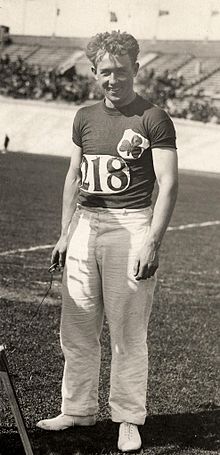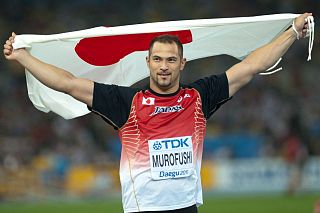
The men's hammer throw competition at the 2004 Summer Olympics in Athens was held at the Olympic Stadium on 20–22 August. There were 35 competitors from 24 nations. After a series of doping-related disqualifications, the event was won by Koji Murofushi of Japan, the nation's first medal in the event. All distances are given in metres.

The men's discus throw was one of four men's throwing events on the Athletics at the 1964 Summer Olympics program in Tokyo. It was held on 15 October 1964. 29 athletes from 21 nations entered, with 1 additional athlete not starting in the qualification round. The maximum number of athletes per nation had been set at 3 since the 1930 Olympic Congress. The event was won by Al Oerter of the United States, the nation's fourth consecutive and 11th overall victory in the men's discus throw. Oerter became the first man to win three medals in the event, all of them gold. He was only the second person to win three consecutive gold medals in any individual athletics event. It was the third of his four consecutive wins in the event. Ludvik Danek of Czechoslovakia took silver to break up the Americans' two-Games dominance of the discus podium; no non-American had won a medal since 1952. Dave Weill earned bronze to make this the fourth straight Games that the United States had won at least two medals in the event.

The men's hammer throw was one of four men's throwing events on the Athletics at the 1964 Summer Olympics program in Tokyo. It was held on 17 October and 18 October 1964, with the qualification on the first day and the final the next. 25 athletes from 14 nations entered, with 1 not starting in the qualification round. The maximum number of athletes per nation had been set at 3 since the 1930 Olympic Congress. The event was won by Romuald Klim of the Soviet Union, the nation's second consecutive victory in the men's hammer throw. Gyula Zsivótzky of Hungary repeated as silver medalist, the fifth man to win multiple medals in the event. Uwe Beyer took bronze, the first medal for the United Team of Germany and the first medal for any German hammer thrower since 1952.

The men's hammer throw was an event at the 1996 Summer Olympics in Atlanta, Georgia. There were 37 competitors from 22 nations, with twelve athletes reaching the final. The maximum number of athletes per nation had been set at 3 since the 1930 Olympic Congress. The eight highest-ranked competitors after three rounds qualified for the final three throws to decide the medals. The qualification mark was set at 76.50 metres. The event was won by Balázs Kiss of Hungary, the nation's first victory in the men's hammer throw since 1968 and fourth overall. Lance Deal earned the United States' first medal in the event since 1956 with his silver. Oleksandr Krykun's bronze gave Ukraine a medal in its debut as an independent nation.
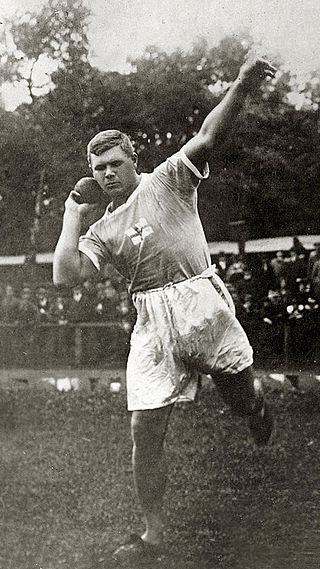
The men's shot put event was part of the track and field athletics programme at the 1920 Summer Olympics. The competition was held on Tuesday, August 17, 1920, and on Wednesday, August 18, 1920. Twenty shot putters from ten nations competed. No nation had more than 4 athletes, suggesting the limit had been reduced from the 12 maximum in force in 1908 and 1912. The event was won by Ville Pörhölä of Finland, the first time the men's shot put was won by someone not from the United States. Fellow Finn Elmer Niklander took silver. The Americans, who had won all five previous editions of the shot put, including three medal sweeps, settled for bronze by Harry B. Liversedge.
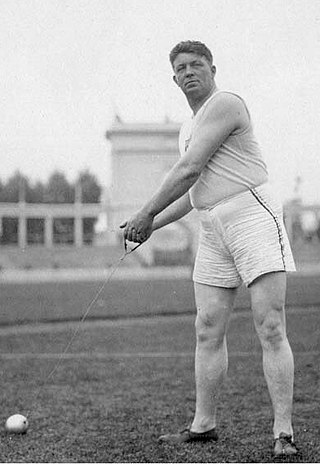
The men's hammer throw event was part of the track and field athletics programme at the 1920 Summer Olympics. The competition was held on Wednesday, August 18, 1920. 12 throwers from 5 nations competed; four from Sweden, four from the United States, two from Canada, one from Great Britain, and one from Finland. No nation had more than 4 athletes, suggesting the limit had been reduced from the 12 maximum in force in 1908 and 1912. The event was won by Patrick Ryan of the United States, the nation's fifth consecutive victory in the event. Carl Johan Lind took silver, earning Sweden's first medal in the hammer throw. Another American, Basil Bennett, earned bronze.

The men's hammer throw at the 1988 Summer Olympics in Seoul, South Korea had an entry list of 30 competitors from 16 nations, with two qualifying groups before the final (12) took place on Monday September 26, 1988. The maximum number of athletes per nation had been set at 3 since the 1930 Olympic Congress. In the final round the eight highest-ranked competitors after three rounds qualified for the final three throws to decide the medals. The event was won by Sergey Litvinov of the Soviet Union, the nation's sixth victory in the event. The Soviet team completed the medal sweep, with Yuriy Sedykh taking silver and Jüri Tamm bronze. It was the Soviets' third medal sweep in four Games, with only the boycotted 1984 Games missing. The 1988 team was the same as the 1980 squad, with Litvinov and Sedykh trading places. Litvinov and Tamm were the ninth and tenth men to earn multiple medals in the hammer throw, while Sedykh became the fourth to win three medals; his two golds and a silver trailed only John Flanagan's three gold medals in Olympic success.

The men's hammer throw was an event at the 1984 Summer Olympics in Los Angeles, California. There were 23 participating athletes from 13 nations. The maximum number of athletes per nation had been set at 3 since the 1930 Olympic Congress. The eight highest-ranked competitors after three rounds qualified for the final three throws to decide the medals. The qualification mark was set at 72.00 metres.

The men's hammer throw event was part of the track and field athletics programme at the 1924 Summer Olympics. The competition was held on Thursday, July 10, 1924. 15 hammer throwers from ten nations competed. The maximum number of athletes per nation was 4. The event was won by Fred Tootell of the United States, the nation's sixth consecutive victory in the event; the Americans would not win again until 1956. Tootell was the first of the winners to have been born in the United States; the previous winners had all been Irish-American. Fellow American Matt McGrath, the 1908 silver medalist and 1912 champion, took silver once again; he was the second man to earn three medals in the hammer throw. Malcolm Nokes earned Great Britain's first medal in the event with his bronze.

The men's shot put event was part of the track and field athletics programme at the 1924 Summer Olympics. The competition was held on Tuesday, July 8, 1924. 28 shot putters from 15 nations competed. The maximum number of athletes per nation was 4. The event was won by Bud Houser of the United States, the nation's sixth victory in the men's shot put. Glenn Hartranft took silver and Ralph Hills took bronze to complete the Americans' fourth medal sweep in the event.

The men's hammer throw at the 2008 Summer Olympics took place on 15 August (qualifying) and 17 (final) at the Beijing National Stadium. There were 33 competitors from 26 nations. The event was won by Primož Kozmus of Slovenia, the nation's first medal in the event.

The men's hammer throw event was part of the track and field athletics programme at the 1928 Summer Olympics. The competition was held on Monday, July 30, 1928. Sixteen hammer throwers from eleven nations competed. The maximum number of athletes per nation was 4. The event was won by Pat O'Callaghan of Ireland, the first gold medal for the nation at the Olympics since it started competing independently in 1924 and the first time the event was won by a non-American. Ossian Skiöld of Sweden took silver, the nation's second medal in the event after another silver in 1920. The Americans, who had earned a gold medal and at least one other medal in each of the previous six hammer throw competitions, took only a bronze this time, with Edmund Black finishing third.

The men's hammer throw event at the 1980 Summer Olympics in Moscow, Soviet Union had an entry list of 17 competitors from 13 nations, with one qualifying group before the final (12) took place on 31 July 1980. Top 12 and ties and all those reaching 72.00 metres advanced to the final. The maximum number of athletes per nation had been set at 3 since the 1930 Olympic Congress. The event was won by Yuriy Sedykh of the Soviet Union, repeating as Olympic champion. He was the eighth man to win multiple medals in the event and third to have at least two gold medals. Just as in 1976, Sedykh led the Soviet team to a medal sweep, with Sergey Litvinov taking silver and Jüri Tamm bronze. The gold medal was the Soviet Union's third consecutive and fifth overall in the men's hammer throw, second all-time to the United States's seven.
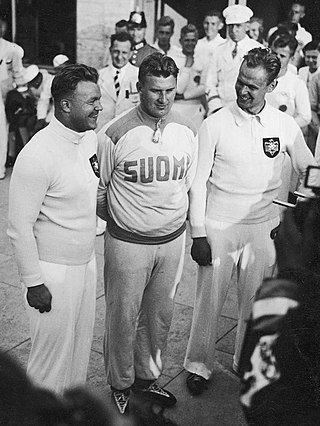
The men's shot put event was part of the track and field athletics programme at the 1936 Summer Olympics. The competition was held on 2 August 1936. Twenty-two athletes from 14 nations competed. The maximum number of athletes per nation had been set at 3 since the 1930 Olympic Congress. The final was won by Hans Woellke of Germany. It was Germany's first victory in the men's shot put, and first medal since bronze in 1928. Germany also received bronze in 1936, with Gerhard Stöck finishing third. Between the two Germans was Sulo Bärlund of Finland with silver, the nation's first medal in the event since gold in 1920. For the first time, the United States won no medals in the men's shot put, with the three Americans finishing 4th, 5th, and 6th.

The men's hammer throw event was part of the track and field athletics programme at the 1936 Summer Olympics. The competition took place on August 3, 1936, with 27 competitors from 16 nations. The maximum number of athletes per nation had been set at 3 since the 1930 Olympic Congress. The final was won by Karl Hein of Germany. The silver medal went to Erwin Blask, also of Germany. They were the first medals for Germany in the event; Germany was also the first country other than the United States to have two medalists in the event in the same Games. Fred Warngård of Sweden took bronze. The United States' eight-Games medal streak in the hammer throw was snapped, with the Americans' best result being William Rowe's fifth place.

The men's hammer throw at the 1960 Summer Olympics took place on September 2 (qualifying) and September 3 (final) at the Stadio Olimpico. The qualifying standards for the 1960 event were 60 m. There were 28 competitors from 18 nations. The maximum number of athletes per nation had been set at 3 since the 1930 Olympic Congress. The event was won by Vasily Rudenkov of the Soviet Union, the nation's first victory in the event. Gyula Zsivótzky took silver, Hungary's fourth medal in the last four Games in the men's hammer throw. Tadeusz Rut's bronze was Poland's first medal in the event.

The men's hammer throw field event at the 1972 Summer Olympics took place on September 4 & 7. There were 31 competitors from 17 nations. The maximum number of athletes per nation had been set at 3 since the 1930 Olympic Congress. The event was won by Anatoliy Bondarchuk of the Soviet Union, the nation's third victory in the men's hammer throw. Fellow Soviet Vasiliy Khmelevskiy took bronze. Silver went to Jochen Sachse of East Germany, the nation's first medal in the event. The Soviet Union's medal streak in the event extended to five Games, while Hungary's ended after three Games.
The men's discus throw event at the 1952 Summer Olympics took place on 22 July at the Helsinki Olympic Stadium. Thirty-two athletes from 20 nations competed. The maximum number of athletes per nation had been set at 3 since the 1930 Olympic Congress. The event was won by Sim Iness of the United States, the nation's eighth victory in the men's discus throw. Defending champion Adolfo Consolini of Italy took silver, becoming the fourth man to win two medals in the event. American James Dillion won bronze.

The men's hammer throw event at the 1952 Summer Olympics took place on 24 July at the Helsinki Olympic Stadium. There were 33 competitors from 18 nations. The maximum number of athletes per nation had been set at 3 since the 1930 Olympic Congress. The event was won by József Csermák of Hungary, the nation's second consecutive victory in the event. Imre Németh, who had won four years earlier, took bronze; he was the fourth man to win multiple medals in the event. Silver went to Karl Storch of Germany.

The men's hammer throw competition at the 1976 Summer Olympics in Montreal, Quebec, Canada took place on 26–28 July. There were 20 competitors from 13 nations. The maximum number of athletes per nation had been set at 3 since the 1930 Olympic Congress. The event was won by Yuriy Sedykh of the Soviet Union, the nation's second consecutive and fourth overall victory in the men's hammer throw. The Soviets swept the medals, with Aleksey Spiridonov taking silver and defending champion Anatoliy Bondarchuk earning bronze. It was the third medal sweep in the men's hammer throw. Bondarchuk was the seventh man to win multiple medals in the event.
